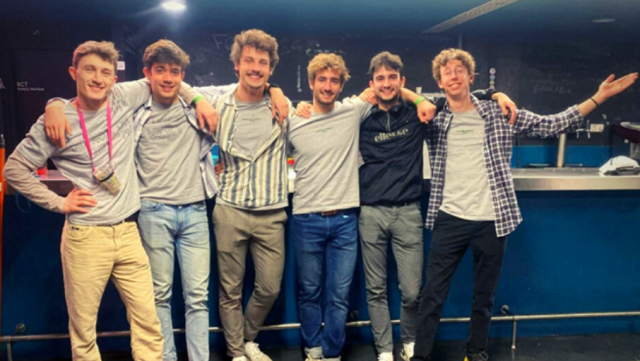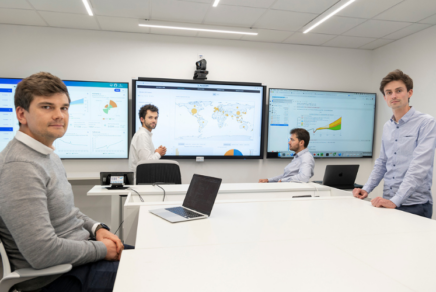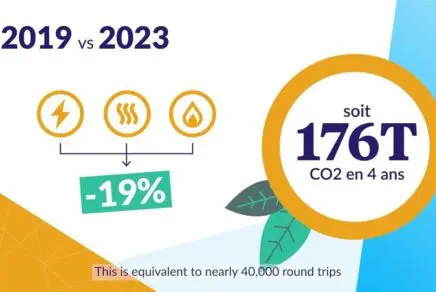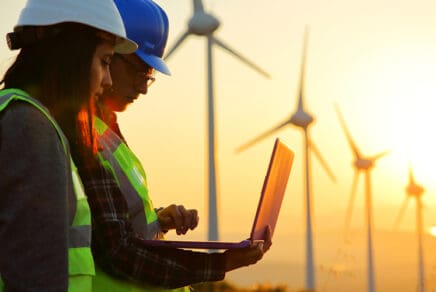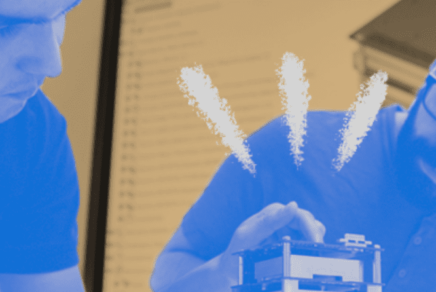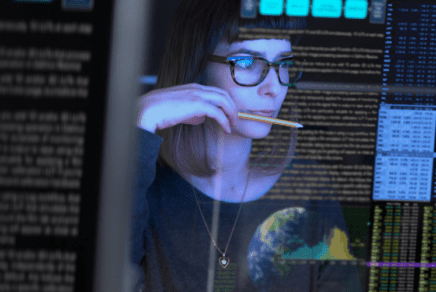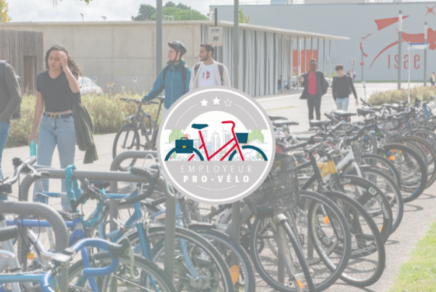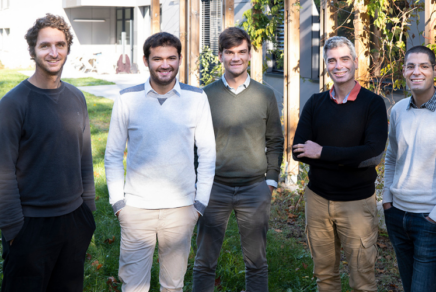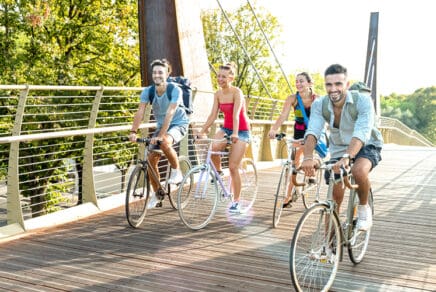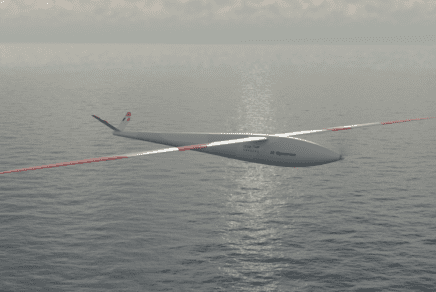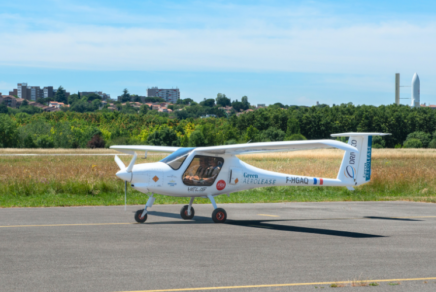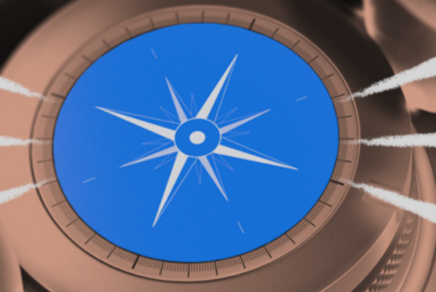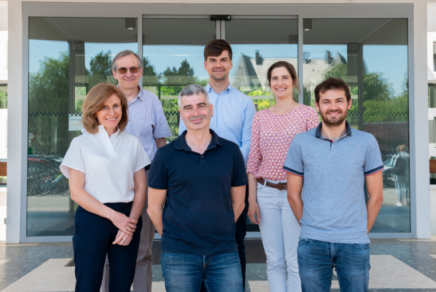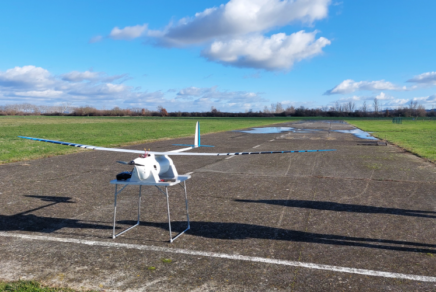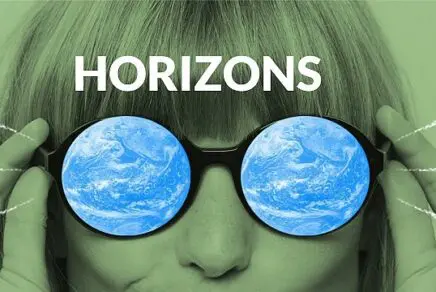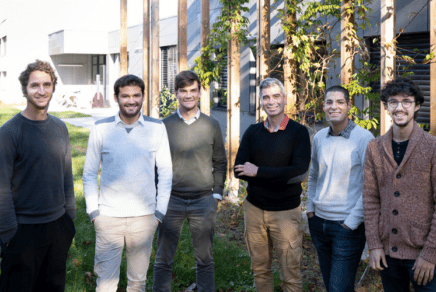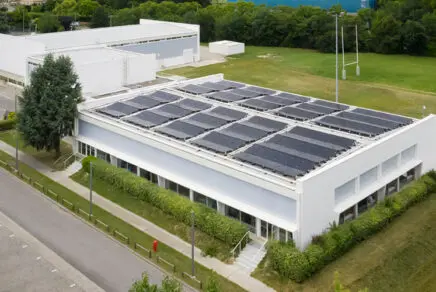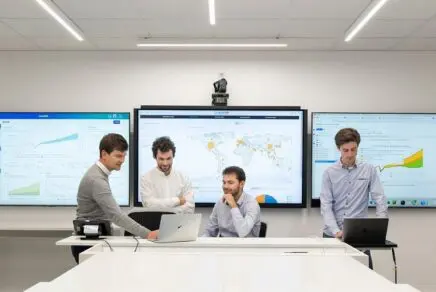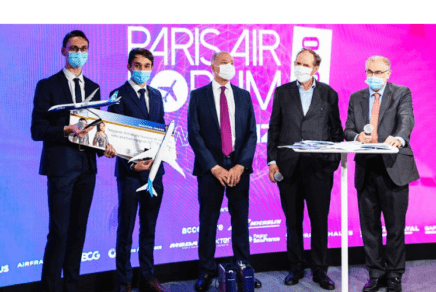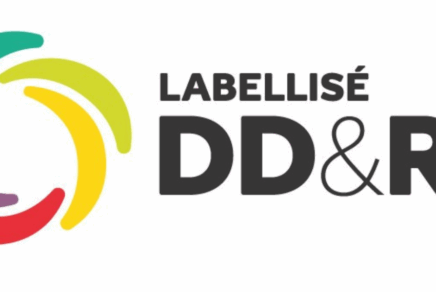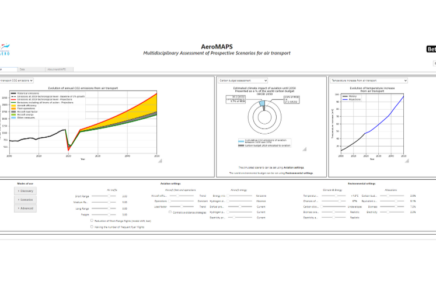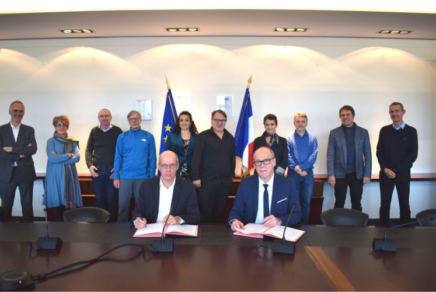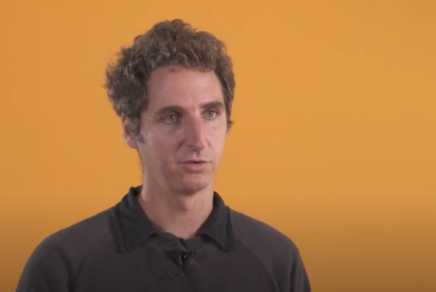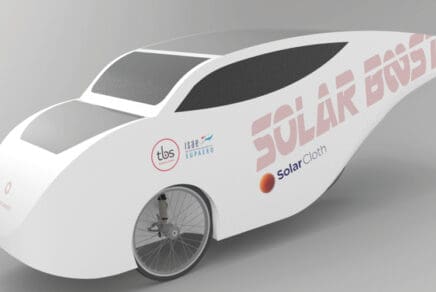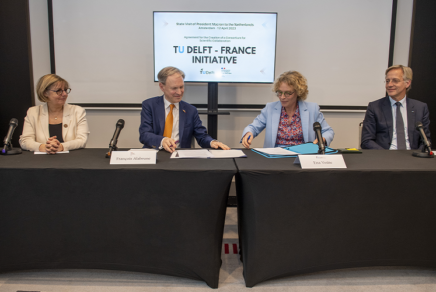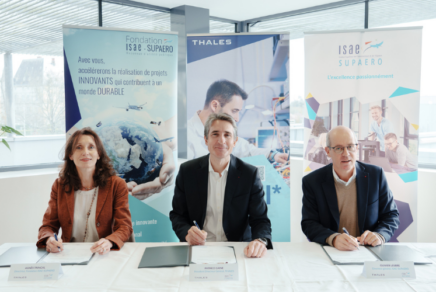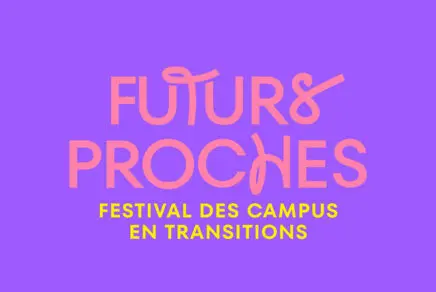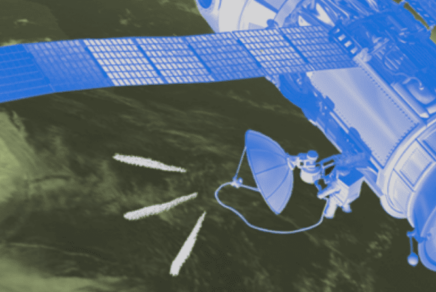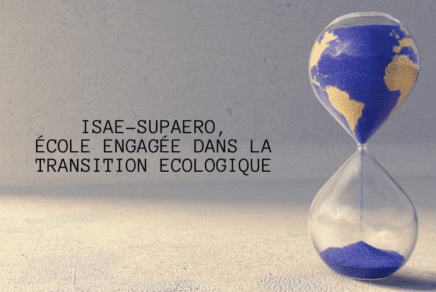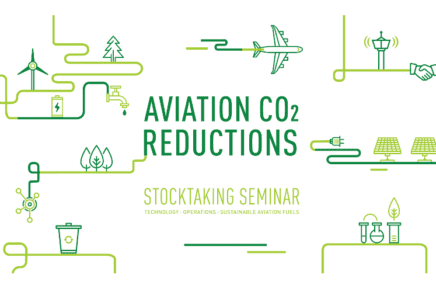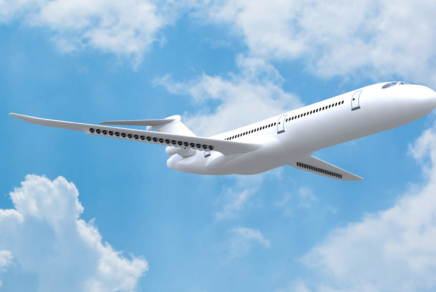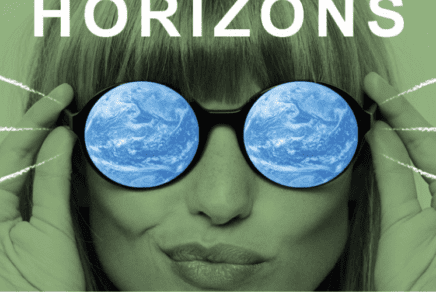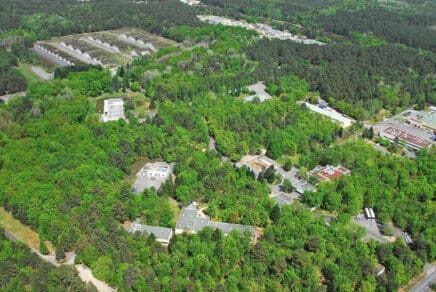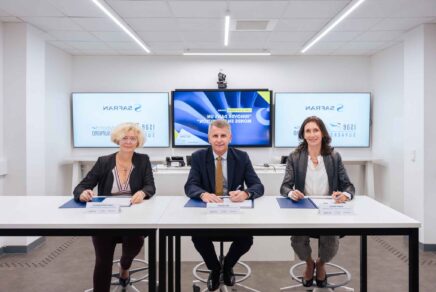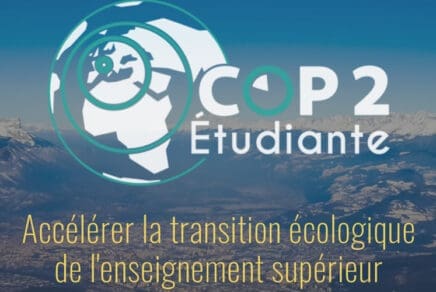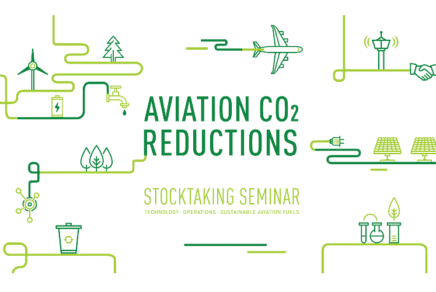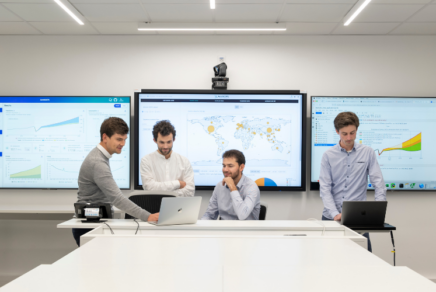L’un des grands axes de notre stratégie « Horizons » s’appuie sur nos actions réalisées en faveur de notre campus. Un campus durable qui devra illustrer au mieux notre volonté d’être exemplaire. Cet axe se traduit par le déploiement d’une stratégie bas carbone visant à réduire nos émissions de gaz à effet de serre et l’adaptation de notre campus aux impacts environnementaux futurs et la réduction des autres impacts environnementaux (notamment biodiversité et ressources).
Sur le même sujet
Actualités
Horizon Europe Pathfinder, le projet européen IPROPLes enjeux environnementaux sont au cœur de la stratégie de la Direction de la Recherche et des Ressources Pédagogique de l’ISAE-SUPAERO. Un engagement qui se traduit par la participation à IPROP, Ionic Propulsion in Atmosphere, un des projets européens de recherche en matière de décarbonation de l’aviation.
Décarbonation
Développement Durable
Actualités
Ensemble, engageons-nous durablement vers de nouveaux horizonsAéronautique
Défi
Développement Durable
Actualités
AeroSCOPE, la première base de données open-source pour explorer les émissions de CO2 du transport aérienDoctorant à l’ISAE-SUPAERO, Antoine Salgas a réalisé une photographie des émissions de CO2 émises par le transport aérien pays par pays, région par région. Ce travail sans équivalent vient nourrir AeroMAPS, une plateforme ouverte de référence visant à explorer les scénarios pour décarboner le transport aérien.
Aéronautique
Décarbonation
Développement Durable
Actualités
L’ISAE-SUPAERO retransmet le Webinaire « Transport aérien en crise et défi climatique : vers de nouveaux paradigmes » sur le campus !L’ISAE-SUPAERO est partenaire du Webinaire « Transport aérien en crise et défi climatique : vers de nouveaux paradigmes » et assurera sa retransmission sur le campus les 11 et 12 mars prochain !
Aérospatial
Développement Durable
Événement
Actualités
Nicolas Cruaud, Ingénieur à l’ISAE-SUPAERO et co-fondateur de la start-up NéolitheNicolas Cruaud, co-fondateur de Néolithe et actuellement étudiant à l’ISAE-SUPAERO nous présente son projet de start-up basé sur la transformation des ordures ménagères en pierres utilisables pour la construction. Un procédé qui remplacerait l’incinération de ces mêmes déchets et qui permettrait ainsi une réduction de 80% des émissions de CO2 normalement émises. Une technologie innovante permettant à terme de réduire l’impact environnemental.
Développement Durable
Présentation
Rencontre
Pages
Notre défi pour la transition environnementaleÀ l'ISAE-SUPAERO, nous nous engageons pour une société durable à travers « Horizons », notre feuille de route en développement durable. Construite autour de cinq axes – former, rechercher et innover, agir pour la transition, adapter notre campus et s’engager durablement – elle guide nos actions concrètes. Portée par un manifeste et un bilan carbone, notre stratégie mobilise chercheurs, enseignants, personnels et étudiants pour accélérer la transition et concevoir l’aéronautique décarbonée de demain.
Développement Durable
Horizons
Actualités
Le site web de l’Institute for Sustainable Aviation (ISA) est en ligne !Le site web de l’Institute for Sustainable Aviation est officiellement en ligne ! Découvrez la vision de l’ISA pour le futur de l’aviation : https://isa-toulouse.com/
Décarbonation
Développement Durable
Vidéos
La sobriété énergétique à l’ISAE-SUPAEROL’ISAE-SUPAERO est pleinement engagé pour réduire son empreinte environnementale, notamment ses consommations énergétiques et sa dépendance aux énergies fossiles. Depuis 2019, notre campus évolue afin d’améliorer la performance énergétique de nos bâtiments. Découvrons ensemble comment se traduisent ces progrès, les actions qui ont été mises en place et nos objectifs pour le futur. Pour en savoir plus : https://www.isae-supaero.fr/fr/horizons-186/vivre-un-campus-bas-carbone/vivre-un-campus-bas-carbone/
Développement Durable
Horizons
RSE
Actualités
L’ISAE-SUPAERO participe au Tour de France Agir Ensemble 2019-2020Participer au Tour de France Agir Ensemble 2019-2020 pour contribuer au développement de campus durables au sein de territoires durables.
Développement Durable
Événement
Actualités
Certificat Ingénierie environnementale de l’ISAE-SUPAERO : former les ingénieurs aux enjeux des transitions environnementales et énergétiquesFormer des ingénieurs capables de comprendre les enjeux, d’avoir une vision holistique sur le cycle de vie, capable d’appréhender la complexité des impacts environnementaux et de la chaine de valeur aéronautique. Le certificat Ingénierie environnementale a été pensé pour offrir aux étudiants toutes les clés pour faire évoluer le rôle des ingénieurs en faveur de la transition écologique et énergétique au sein des entreprises.
Aéronautique
Certification
Développement Durable
Témoignages
Témoignage d'Alice Fabre, alumni promotion 2021 du Mastère Spécialisé® TAS AEROAéronautique
Alumni
Décarbonation
Pages
Explorer, partager, transformerCréer des lieux de discussion ouverts pour faciliter les échanges sur les enjeux de la transition du secteur aérospatial, contribuer à l’innovation, partager notre expertise et la rendre accessible, croiser les regards, favoriser l’inclusion et l’ouverture autour de ces sujets : nous agissons collectivement pour la transition à l’échelle internationale.
Développement Durable
Horizons
Actualités
Clean Aviation – Le projet européen CONCERTOLes enjeux environnementaux sont au cœur de la stratégie de la Direction de la Recherche et des Ressources Pédagogique de l’ISAE-SUPAERO. Un engagement qui se traduit par la participation à CONCERTO « Construction Of Novel CERTification MethOds and Means of Compliance for Disruptive Technologies », un des projets européens de recherche en matière de décarbonation de l’aviation.
Décarbonation
Développement Durable
Actualités
Journée Mondiale de l’Ingénieur 2020 : un jeune alumni met ses compétences d’ingénieur au service du climatA l’occasion de la "Journée Mondiale de l’Ingénieur 2020" orientée sur la thématique du développement durable, nous vous proposons le portrait de Maxime Efoui Hess.
Alumni
Développement Durable
Portrait
Actualités
L’ISAE-SUPAERO est officiellement labellisé Employeur Pro-Vélo !Porté par la Fédération des Usagers de la Bicyclette (FUB) et soutenu par l’ADEME, le label Employeur Pro-Vélo valorise les sites employeurs qui mettent en œuvre des actions pro-vélo ambitieuses. L’ISAE-SUPAERO est fier d’annoncer sa labellisation niveau Argent.
Développement Durable
Label
RSE
Actualités
Aviation et Climat : une évaluation des scénarios de transition pour une aviation durable compatible avec l’accord de ParisEn 2021, des chercheurs de l’ISAE-SUPAERO Scott Delbecq, Jérôme Fontane, Nicolas Gourdain, Florian Simatos, Thomas Planès publiaient le référentiel « Aviation et Climat » synthétisant les publications scientifiques internationales afin de proposer les éléments scientifiques nécessaires à la compréhension des enjeux de la décarbonation du transport aérien.
Aéronautique
DCAS
Décarbonation
Actualités
Investir et s'investir dans la formation et la recherche pour répondre aux enjeux de la transition énergétiqueL’ISAE-SUPAERO et la Fondation ISAE-SUPAERO travaillent de concert et prennent leur part de responsabilité pour relever ces défis majeurs pour notre société. Des actions passant par la sensibilisation et la formation des futurs ingénieurs aéronautiques et par la mise en place de programmes de recherche permettant une meilleure prise en compte des enjeux liés à l’énergie et au climat.
Aérospatial
Développement Durable
Actualités
OSE l’ISAE-SUPAERO : un engagement durableL’enseignement supérieur et la recherche sont des leviers majeurs de la transition vers une société durable. Ces dernières années, la sensibilité des étudiants aux questions d’environnement est devenue prégnante, comme l’attestent leur participation et intérêt sur des projets dédiés. OSE l’ISAE-SUPAERO, le programme d’ouverture sociale de l’Institut, a ainsi proposé à ces étudiants d’intervenir dans des collèges et des lycées pour sensibiliser les jeunes aux problématiques liées à l’environnement.
Développement Durable
Ouverture sociale
Actualités
Le projet d’un avion sans pilote, zéro émission pour traverser l’Atlantique SudLe projet Drone Mermoz, initié par une équipe de chercheurs du laboratoire d’aérodynamique de l’ISAE-SUPAERO a pour ambition de participer au développement de technologies de rupture pour l’aviation électrique. Traverser l’Atlantique Sud avec un aéronef d’environ 4 mètres d’envergure sans pilote et à propulsion hydrogène représenterait un premier pas vers le développement d’avions bas-carbone de plus grande taille pour le transport aérien.
Chercheur
Développement Durable
Innovation
Actualités
Des vols en avion électrique pour sensibiliser à l’aviation décarbonéeEn juin, vingt-quatre élèves et personnels de l’ISAE-SUPAERO ont pu voler sur le Velis Electro, le premier avion 100 % électrique certifié au monde.
Aéronautique
Décarbonation
Développement Durable
Pages
Nous engager durablement vers de nouveaux "Horizons"Développement Durable
Horizons
Actualités
L’ISAE-SUPAERO met au point une méthodologie pour quantifier l’impact de ses projets de recherche sur l’environnementLa Direction de la Recherche a initié une métrique pour évaluer l’ambition des activités de recherche de l’ISAE-SUPAERO dans la transition vers une société durable. L’évaluation révèle que plus d’un tiers (35%) des projets de recherche menés à l’Institut visent un impact significatif sur l’environnement.
Développement Durable
Horizons
Actualités
Aviation décarbonée : premier essai en vol réussi pour le Drone Mermoz propulsé à l’hydrogèneCourant janvier, le premier démonstrateur « Drone Mermoz » embarquant de l’hydrogène gazeux, développé par l’ISAE-SUPAERO en partenariat avec H3 DYNAMICS, a effectué avec succès son premier vol radiocommandé sur la piste du club d’aéromodélisme de Muret en région toulousaine (31).
Décarbonation
Développement Durable
Actualités
Neutralité carbone : Quelle stratégie pour l’ISAE-SUPAERO ?Depuis quelques années, nous entendons parler de façon régulière de changement climatique, d’émission de gaz à effet de serre ou encore de neutralité carbone. Mais il faut bien avouer qu’il est parfois difficile de s’y retrouver au milieu de tous ces termes notamment face à une poussée de « l’éco-blanchiment » ou greenwashing de la part de certains acteurs. Nous tenterons d’exposer la vision de l’ISAE-SUPAERO sur la prise en compte de son impact climatique dans sa stratégie globale.
Développement Durable
Pages
Comprendre les enjeux via notre Référentiel aviation et climatPeut-on caractériser l’impact de l’aviation sur le climat ? Quels sont les enjeux aviation et climat ? Peut-on comparer les effets CO2 et les effets non CO2 ? Quelles sont les solutions technologiques étudiées pour rendre l’aviation durable ? Peut-on relier la vitesse d’évolution du trafic aérien à la part du budget carbone consacrée à l’aviation ? Peut-on faire un bilan des ressources énergétiques disponibles ?
Développement Durable
Horizons
Vidéos
HORIZONS, la stratégie renouvelée de l’ISAE-SUPAERO en matière de développement durableÀ l’ISAE-SUPAERO, nous avons mis les enjeux environnementaux au cœur de notre engagement. Nous mobilisons donc nos compétences pédagogiques et notre expertise scientifique pour contribuer à construire les composantes aéronautique et spatiale de cette société durable et en particulier pour inventer le transport aérien décarboné de demain.
Développement Durable
Horizons
Actualités
Imaginer un transport aérien responsableDéfi relevé par trois élèves ingénieur avec l’objectif de proposer une vision de l’industrie aéronautique décarbonée à 20 ans, afin de limiter l’impact de l’aviation sur l’environnement tout en garantissant l’économie de ce secteur. Des idées qu’ils ont souhaité soumettre à leurs prédécesseurs pour s’imprégner de leur expérience et de la réalité du terrain.
Aéronautique
Défi
Développement Durable
Actualités
Décarbonation de l’aérien : l’ISAE-SUPAERO ouvre une formation pour les professionnels avec le GIFASCette formation d’une journée a pour but d’aider les salariés du secteur aéronautique à jouer un rôle actif et éclairé sur la décarbonation du secteur. Les deux premières sessions se tiendront les jeudi 3 avril 2025 à Toulouse et jeudi 10 avril 2025 à Paris.
Aéronautique
Cursus
Décarbonation
Actualités
L’ISAE-SUPAERO publie un référentiel Aviation et ClimatLe 18 octobre dernier, l’ISAE-SUPAERO a dévoilé son référentiel « Aviation et Climat » pour nourrir le débat de l’impact de l’aviation sur le réchauffement climatique. Ce document de référence synthétise les dernières publications scientifiques internationales, et fournit les éléments concrets nécessaires à la compréhension des enjeux de la décarbonation du transport aérien. Un rapport scientifique inédit pour permettre la construction d’opinions éclairées sur les enjeux et pistes d’innovation aviation et climat !
Développement Durable
Enseignant-chercheur
Actualités
L’ISAE-SUPAERO publie son bilan carboneUn Français émet en moyenne 9 tonnes de CO2e/an. Afin de respecter l’Accord de Paris et de limiter le réchauffement climatique à +1,5°C, l’empreinte carbone doit être réduite à 2 tonnes de CO2e par personne et par an d’ici à 2050.
Développement Durable
Vidéos
AeroMAPS : un outil de référence ISAE-SUPAERO pour explorer les futurs possibles de l’aviationL’outil AeroMAPS, développé par deux chercheurs de l’ISAE-SUPAERO, Scott Delbecq et Thomas Planès, permet d’évaluer les impacts environnementaux du transport aérien et l’efficacité ou les limites des leviers pour décarboner le secteur ! Pensé initialement pour la recherche et la formation, l’outil est désormais une plateforme multidisciplinaire, open source, accessible aussi bien aux experts qu’aux décideurs institutionnels, industriels ou associatifs. Son développement a été intégré aux travaux de l’Institute for Sustainable Aviation (ISA), institut de recherche interdisciplinaire dirigé par Laurent Joly, et dont l’objectif est d’aborder la question de la transition écologique de l’#aviation dans toute sa complexité. En jouant sur les leviers de transition du secteur, l’utilisateur d’AeroMAPS peut définir les scénarios dont il souhaite analyser les impacts. Par exemple, la mise en service de nouveaux types d’avions, l’utilisation de nouveaux carburants ou encore le taux de croissance du trafic aérien. AeroMAPS est la première plateforme d’exploration des scénarios du transport aérien bâtie sur une base méthodologique scientifique open-source. Elle a d’abord été pensée et développée pour permettre aux chercheurs une exploration fine de scénarios de transition du transport aérien. Elle a ensuite rapidement été intégrée à la formation : d’abord dans le cursus ingénieur de l’ISAE-SUPAERO, puis dans les programmes de formation continue. Pour faciliter l’utilisation de l’outil, un partenariat a été noué avec Sopra Steria. C’est cet acteur majeur de la tech qui a bâti la nouvelle interface web de la plateforme afin d’améliorer l’expérience utilisateur et la rendre accessible aux décideurs. Les travaux de recherche ont récemment pris une dimension socio-économique avec un doctorat préparé par Antoine Salgas, en partenariat avec TBS Education. Antoine Salgas a également créé un inventaire de trafic et d’émissions dans le cadre d’une collaboration avec l’université néerlandaise Delft University of Technology. Ces deux volets de sa thèse ont donnée naissance à un outil "satellite" de AeroMAPS, appelé AeroSCOPE, qui permet de partitionner et de régionaliser les analyses. Aujourd’hui, l’aspect complet et pluridisciplinaire d’AeroMAPS constitue une aide à la prise de décision pour l’ensemble de l’écosystème #aéronautique. Par son expertise scientifique, l’ISAE-SUPAERO contribue ainsi au débat et au futur de l’aviation.
DCAS
Décarbonation
Développement Durable
Vidéos
L’engagement des étudiants ISAE-SUPAERO autour du Développement Durable ISAE-SUPAEROL’engagement des étudiants ISAE-SUPAERO autour du Développement Durable ISAE-SUPAERO
Décarbonation
Développement Durable
Actualités
Corentin Lefloch, élève ingénieur, reçoit le premier prix aux USAIRE STUDENT AWARDS pour ses réflexions sur l’aviation du futurCorentin Lefloch, étudiant en 3ème année, et Florian Gandon, étudiant de Sciences Po Paris, se sont distingués parmi plus d’une centaine d’étudiants du monde entier et se sont vu remettre le 1er prix USAIRE en novembre dernier à Paris. La thématique « Be green, keep flying » invitait les étudiants à réfléchir à un ensemble de réformes qui permettront à l’industrie aéronautique d’acter son impérative transition verte.
Développement Durable
Prix
Actualités
L’ISAE-SUPAERO labellisé Développement Durable et Responsabilité Sociétale (DD&RS)L’Institut obtient le label Développement Durable et Responsabilité Sociétale (DD&RS), une reconnaissance officielle de sa stratégie environnementale et sociétale. Avec l’obtention de ce label, notre école confirme sa volonté de faire de la transition écologique et sociétale un levier d’innovation au service de la formation, de la transformation des filières industrielles et d’évolution des pratiques dans la vie quotidienne sur le campus.
Développement Durable
Label
Responsabilité sociétale
Pages
L'Institute for Sustainable AviationCréé en 2021 à l’initiative d’institutions académiques de renommée internationale et dotées d’une expertise académique de longue date dans le domaine de l’aéronautique et du transport aérien, l’ISA est un institut dédié aux enjeux de la transition de l’aviation vers la durabilité.
Aéronautique
Aviation
Décarbonation
Actualités
AeroMAPS : un outil pour évaluer les impacts environnementaux de la transition du secteur aérienL’ISAE-SUPAERO publie en open source AeroMAPS, un outil de modélisation des scénarios de transition pour le secteur aérien. Fruit de trois années de recherche au sein de l’Institut, il permet notamment d’évaluer finement l’efficacité de différentes stratégies de réduction d’impact vis-à-vis des engagements internationaux de lutte contre le changement climatique.
Décarbonation
Développement Durable
Témoignages
Témoignage de Nathanaël Lecompte, alumni promotion 2021 du cursus ingénieur généralisteNathanaël est un jeune diplômé de l’ISAE-SUPAERO, ingénieur de formation, qui, parmi toutes les opportunités qui s’offraient à lui, a choisi la filière des énergies renouvelables. Il nous explique ses motivations et son parcours !
Alumni
Développement Durable
Témoignage
Pages
Former pour l’avenirÀ l’ISAE-SUPAERO, nous formons nos étudiants à relever le défi de la transition énergétique. En les accompagnant dans leur approche systémique, leur capacité à maîtriser les systèmes complexes et leur engagement dans le débat public, nous leur donnons les clés pour inventer le monde de demain.
Développement Durable
Horizons
Actualités
Nos alumni ont la parole : Vinh Ly co-fondateur de KyanosOriginaire de Clermont Ferrand, Vinh LY a débuté son cursus en intégrant une classe préparatoire mathématique et physique avant de rejoindre l’ISAE-SUPAERO où il a obtenu son diplôme d’ingénieur en 2005. Passionné par l’entrepreneuriat et l’innovation, il est aujourd’hui le Président cofondateur de Kyanos Biotechnologies, une start-up green spécialisée dans la production de microalgues.
Alumni
Carrière
Développement Durable
Actualités
Clean Aviation – le projet européen HERALes enjeux environnementaux sont au cœur de la stratégie de la Direction de la Recherche et des Ressources Pédagogique de l’ISAE-SUPAERO. Un engagement qui se traduit par la participation à HERA, Hybrid Electric Regional Aircraft, un des projets européens de recherche en matière de décarbonation de l’aviation.
Décarbonation
Développement Durable
Actualités
L’ISAE-SUPAERO et l’ENAC collaborent à la conception d’une formation diplômante 100% digitale en anglais sur le sujet des transitions de l’aviation !L’ISAE-SUPAERO et l’ENAC forment, autour des enjeux de l’aérospatial et du transport aérien, des ingénieurs de haut niveau scientifique, humanistes, innovants et capables de maîtriser la complexité des défis du monde de demain.
Décarbonation
Développement Durable
Vidéos
L’ISAE-SUPAERO publie son Référentiel Aviation et ClimatLe référentiel Aviation et Climat de l’ISAE-SUPAERO a pour vocation de fournir des éléments #scientifiques utiles à la compréhension des enjeux sur l’aviation et le climat. Ces travaux ont été soumis à un processus de relecture spécifique, intégrant à la fois du personnel de l’ISAE-SUPAERO et des chercheurs extérieurs issus de différents instituts. Trois objectifs pour ce rapport : - Faire émerger une culture commune au sein de l'Institut sur ces questions - Soutenir les industriels dans leur stratégie de décarbonation - Alimenter les réflexions dans les débat autour de l'avenir du secteur aérien
Chercheur
Décarbonation
Développement Durable
Pages
Nos offres de recrutementAéronautique
Aérospatial
Décarbonation
Actualités
Projet SOLAR BOOST, pour contribuer à résoudre la problématique du transport en zone urbaniséeL’ISAE-SUPAERO soutient les initiatives, de plus en plus nombreuses, des étudiants en faveur du développement durable. Zoom sur le projet SOLAR BOOST, un projet de véhicule léger à motorisation électrique. Entreprises, vous pouvez dès maintenant soutenir le développement de ce projet !
Décarbonation
Développement Durable
Actualités
L’ISAE-SUPAERO intensifie sa collaboration avec TU Delft sur l’aviation durableA l’occasion de la visite d’Etat du Président Macron aux Pays-Bas, cinq accords ont été signés afin d’intensifier la collaboration entre les deux pays dans le domaine scientifique et technologique. Parmi eux, un accord entre la TU Delft et la France prévoit une collaboration étroite entre l’ISAE-SUPAERO et TU Delft dans le domaine de l’aviation durable.
Décarbonation
Développement Durable
Partenariat
Actualités
Thales et l’ISAE-SUPAERO renforcent leurs liens pour œuvrer à un système de transport aérien plus durableLe groupe de hautes technologies français apporte son soutien à l’Institut par le biais d’une chaire de recherche. À la clef : une thèse sur une approche intégrée du transport aérien et onze bourses d’excellence pour soutenir des étudiants européens de très haut niveau.
Aéronautique
Décarbonation
Développement Durable
Actualités
L’ISAE-SUPAERO participe au festival Futurs ProchesL’ISAE-SUPAERO en partenariat avec l’Université de Toulouse vous donne rendez-vous le Jeudi 3 Octobre pour le Festival Futurs Proches, Festival des Campus en transitions. Balade naturaliste, escape game autour du handicap, présentation du Référentiel Aviation Climat, etc. Découvrez le programme de notre campus !
Développement Durable
Pages
Répondre aux enjeux environnementauxTraverser l’Atlantique en avion ou envoyer un humain sur la Lune : depuis un siècle, la recherche aérospatiale n’a eu de cesse de réaliser ce que beaucoup croyaient impossible. Le défi de la transition écologique est d’ambition comparable : à l'ISAE-SUPAERO, nous nous mobilisons pour le relever et répondre aux enjeux environnementaux et sociétaux qui sont les nôtres. 35% de projets de recherche internes et collaboratifs visent directement la décarbonation ou sont en lien avec la transition vers l’aérospatial soutenable en 2024.
Développement Durable
Horizons
Actualités
Nos alumni ont la parole : Rencontre avec Nathanaël Lecompte (S2021)Nathanaël est un jeune diplômé de l’ISAE-SUPAERO, ingénieur de formation, qui, parmi toutes les opportunités qui s’offraient à lui, a choisi la filière des énergies renouvelables. Il nous explique ses motivations et son parcours !
Développement Durable
Témoignage
Actualités
ISAE-SUPAERO dans le Top 3 des établissements les plus engagés dans la transition écologique et sociétale !Les Echos START et ChangeNOW ont publié un classement des établissements les plus avancés en matière de transition écologique et sociale. ISAE-SUPAERO se classe en 3ème position d’après les réponses à un questionnaire adressé à 269 écoles et universités dont une cinquantaine d’établissements ont accepté de participer.
Classement
Développement Durable
Actualités
L’institut participe à la transition écologique de l’écosystème aérospatialInvitée par les acteurs de l’aéronautique et de l’espace, Marie-Hélène Baroux, Directrice Générale Adjointe et responsable du Développement Durable s’est exprimée sur le climat et ses enjeux, les formations et les recherches menées à l’ISAE-SUPAERO pour répondre aux problématiques du développement durable de cette rentrée universitaire.
Aérospatial
Développement Durable
Rencontre
Actualités
Des travaux sur la décarbonation de l’aviation récompensés par l’American Institute of Aeronautics and Astronautics (AIAA)Paul Saves, doctorant ISAE-SUPAERO/ONERA remporte le prix du meilleur papier 2022 délivré par l’AIAA pour ses travaux en Conception Optimale Multidisciplinaire (Multidisciplinary Design Optimization - MDO).
Décarbonation
Développement Durable
Actualités
L’ISAE-SUPAERO lance « Horizons », sa nouvelle stratégie en faveur du Développement DurableFace au réchauffement climatique, chacun est appelé à contribuer : le temps n’est plus au constat, encore moins au déni. L’enseignement supérieur et la recherche sont des leviers majeurs de la transition vers une société durable. Ces dernières années, la sensibilité des étudiants aux questions d’environnement est devenue prégnante, comme l’attestent leur participation et intérêt sur des enseignements et projets dédiés.
Développement Durable
Groupe ISAE
Actualités
Nos partenaires se mettent au vert !De nombreuses initiatives en faveur du développement durable voient le jour. Comme il est souvent bon de s’inspirer des bonnes pratiques de chacun, nous avons donné la parole à plusieurs de nos entreprises partenaires pour qu’elles nous présentent quelques-unes de leurs innovations en faveur de la transition écologique. Aussi, Liebherr, MBDA, Thales et Dassault nous disent tout !
Développement Durable
Partenaire
Pages
Innover dans un monde en transition - SafranLes défis des secteurs aéronautique et spatial (transition énergétique, New Space, digitalisation) entrainent un besoin accru de professionnels en capacité d’innover. Dans ce contexte, Safran, l’ISAE-SUPAERO créent la chaire Innover dans un monde en transition.
Aéronautique
Aérospatial
Chaire
Actualités
COP2 Etudiante : L’ISAE-SUPAERO affirme son engagement pour la transition écologique en signant l’Accord de GrenobleUn accord qui a vocation à accélérer le processus de transition socio-écologique des établissements de l’Enseignement Supérieur et de la Recherche ainsi que la prise de conscience des citoyen.ne.s par l’éducation.
Développement Durable
Actualités
Classement des grandes écoles les plus engagées dans la transition écologique : L’ISAE-SUPAERO à la 2ème place !Le classement ChangeNOW/Les Echos START, qui valorise la prise en compte des enjeux environnementaux et sociaux des écoles, à côté des critères d’excellence traditionnels, est de retour. Les actions menées cette année par l’Institut sont récompensées par une 2ᵉ place au classement général !
Classement
Développement Durable
Actualités
Congrès de l’OACI (Organisation de l’Aviation Civile Internationale) : Laurent Joly, Directeur adjoint de la Recherche à l’ISAE-SUPAERO, s’exprime sur les engagements de l’InstitutLe séminaire 2021 de l’OACI sur le bilan des réductions des émissions de CO2 dans le secteur de l’aviation a eu lieu du 31 Août au 3 septembre 2021, entièrement en ligne. Laurent Joly, Directeur adjoint de la Recherche a été invité à prendre la parole lors de la session « Aviation and the importance of emissions reduction goals ».
Défi
Développement Durable
Événement
Actualités
AeroMAPS : l’outil de référence pour explorer les futurs possibles de l’aviationL’outil AeroMAPS, développé par des chercheurs de l’ISAE-SUPAERO, permet d’évaluer les impacts environnementaux du transport aérien et l’efficacité ou les limites des leviers pour décarboner le secteur.
Aéronautique
DCAS
Décarbonation
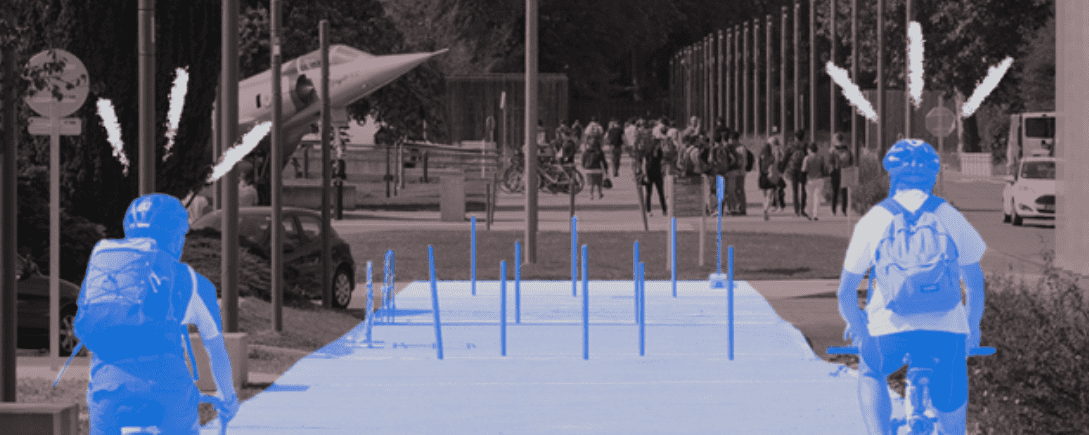
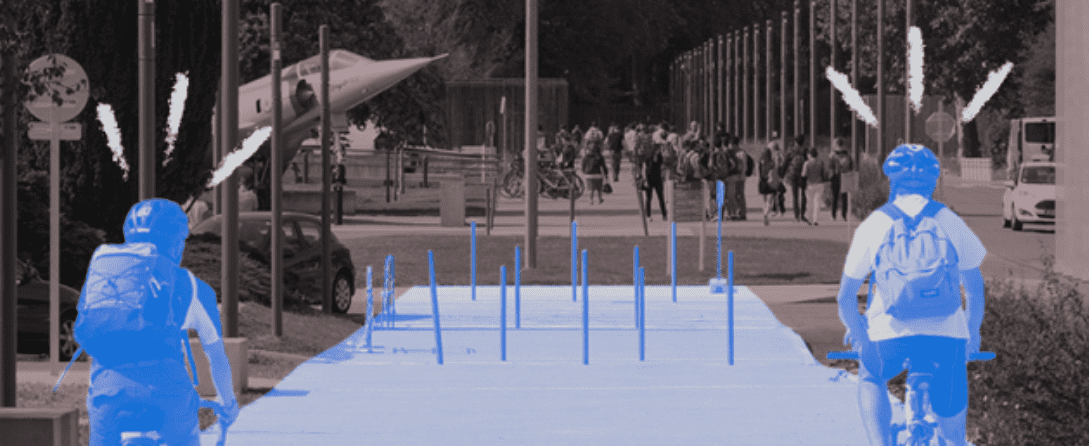
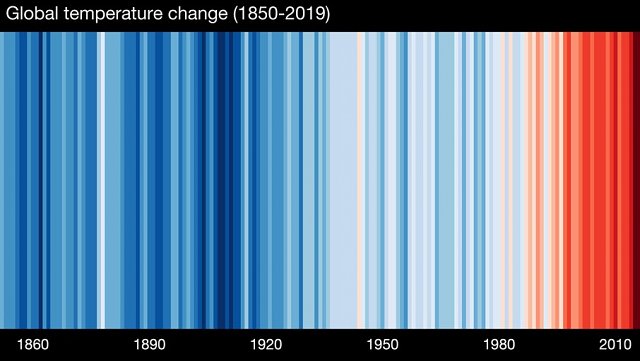 L’augmentation de la concentration en gaz à effet de serre (GES) et notamment celle du CO2 dans l’atmosphère a déjà conduit à un réchauffement global de plus de 1,1 °C par rapport à l’ère préindustrielle et pourrait atteindre +6 à +7 °C d’ici à la fin du siècle (à titre de comparaison, le dernier âge glaciaire était plus froid de seulement 4 à 5 °C par rapport à l’ère préindustrielle).
L’augmentation de la concentration en gaz à effet de serre (GES) et notamment celle du CO2 dans l’atmosphère a déjà conduit à un réchauffement global de plus de 1,1 °C par rapport à l’ère préindustrielle et pourrait atteindre +6 à +7 °C d’ici à la fin du siècle (à titre de comparaison, le dernier âge glaciaire était plus froid de seulement 4 à 5 °C par rapport à l’ère préindustrielle).
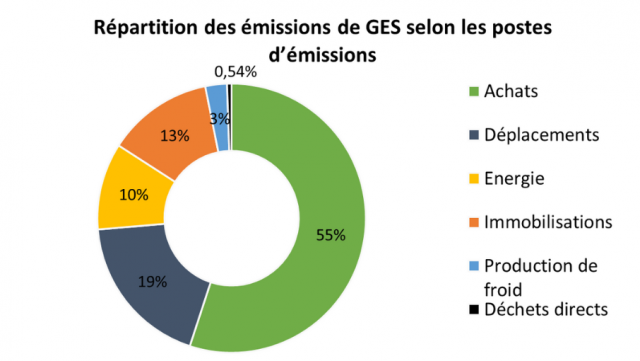
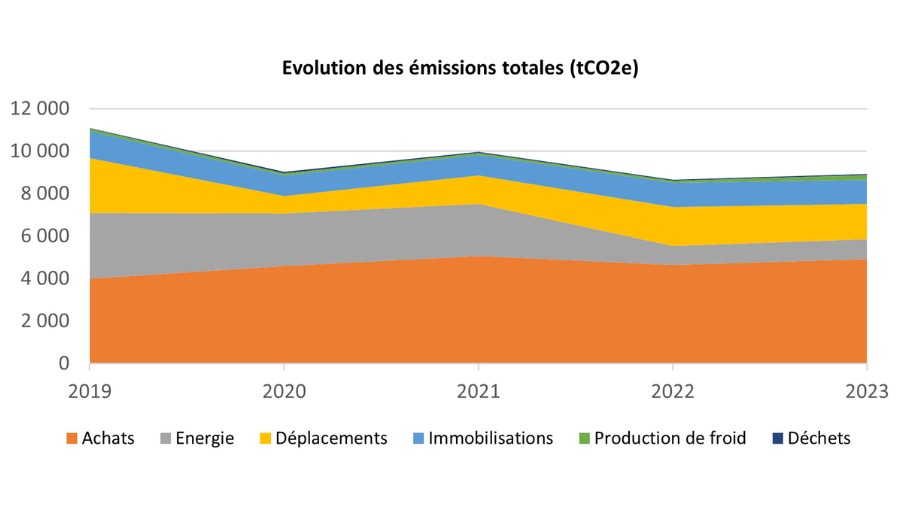
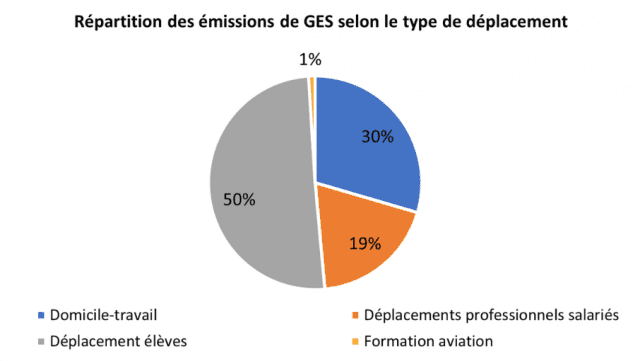
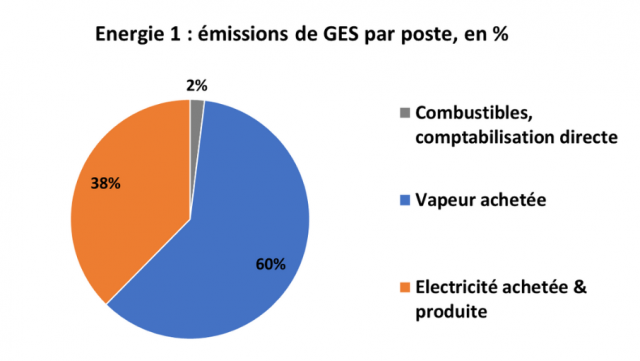
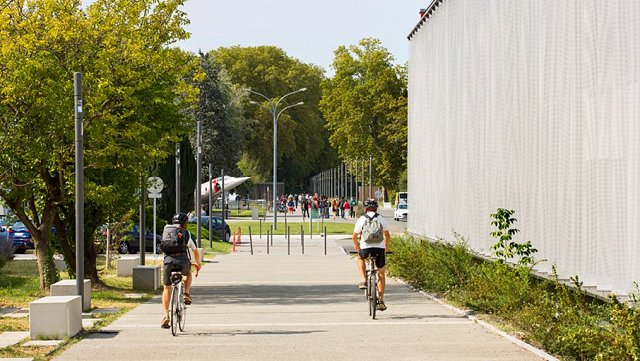
 Notre école a également participé à l’opération « AYAV » (Allons-Y A vélo). Cette opération propose aux entreprises de se challenger durant une semaine en incitant un maximum de leurs collaborateurs à se rendre sur leur lieu de travail à vélo.
Notre école a également participé à l’opération « AYAV » (Allons-Y A vélo). Cette opération propose aux entreprises de se challenger durant une semaine en incitant un maximum de leurs collaborateurs à se rendre sur leur lieu de travail à vélo.
